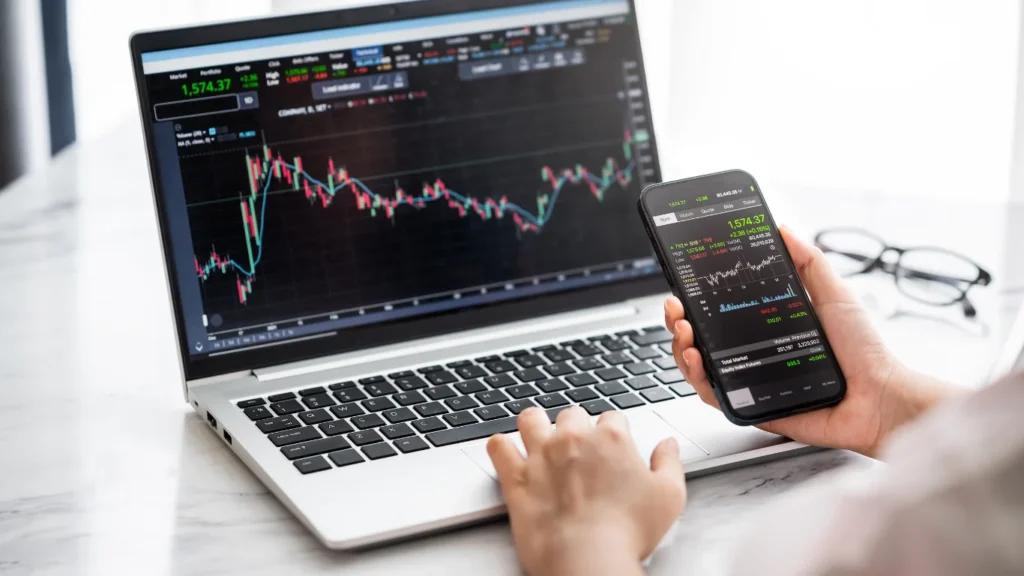Starting to trade in an IPO is exciting but complex. It means a company’s shares are opening to the public for the first time. This moment is crucial and can lead to smart investment choices. To do well, one needs to know important tips and follow a guide on IPO investments.
Table of contents
- Understanding IPOs
- Pre-IPO Research Strategies
- Eligibility and Access to IPO Trading
- How To Trade An IPO: A Step-by-Step Guide
- IPO Trading Platforms and Brokers
- Strategies for Trading Newly Listed Stocks
- Risk Management in IPO Trading
- Spotting IPO Investment Opportunities
- The Importance of Timing in IPO Stock Trading
- Common Misconceptions About IPO Trading
Article Summary
The article provides a comprehensive guide for individuals looking to trade in an Initial Public Offering (IPO).
The guide emphasizes the complexity and excitement of trading in an IPO, which involves a company’s shares being listed on a stock exchange for the first time. It outlines the necessary steps to take, including understanding the IPO process, researching the company, setting a budget, and choosing a brokerage firm.
Additionally, the guide highlights the importance of timing and patience, as IPOs can be volatile and may experience significant price fluctuations in the early stages.
When a company goes public through an IPO, it gains in many ways. It can get money for growth, pay off debts, and fund daily needs. The company gets more noticed, can attract skilled workers, plan strategic buys, and find more finance options.
Yet, traders must think about the downsides too. These include high costs for legal and marketing work, lots of prep time, the risk of not getting enough funds, and having to share more company info. IPOs are strictly controlled and differ around the world, so following rules carefully is key.
Key Takeaways
- Initial public offerings (IPOs) mark a company’s transition from private to public status, offering shares to both institutional and retail investors.
- The involvement of investment banks in underwriting IPOs is crucial, as they assist in share allocation and price determination.
- An IPO’s success can enrich a company by providing significant capital for growth while also presenting potential risks such as legal expenses and increased disclosure.
- Regulatory governance of IPOs, including the requirements set by the U.S. SEC and the UK Listing Authority, reinforces the importance of legality and accuracy in the IPO process.
- Thorough preparation, inclusive of establishing a robust management team and corporate governance structure, is imperative for IPO planning.
- Understanding the roles and compensation of underwriters and their syndicates can enhance an investor’s comprehension of the financial dynamics at play in IPOs.
- Effective IPO trading strategies hinge on comprehensive research, including the examination of a company’s fundamentals and the evaluation of the investment bank’s track record.

Understanding IPOs
Starting an Initial Public Offering (IPO) is a huge step for a private company. An IPO is when a company starts selling its shares to the public and big investors. This move helps them grow, share ownership, and get into capital markets for expanding and managing debt. But, it also means they have to follow strict legal rules and share a lot of their financial info.
What is an IPO and How Does It Work?
The IPO process is about getting ready, showing off, and selling company shares to investors. It’s complex, needing a lot of planning and following strict rules, including how many shares must be sold.
The first IPO in the U.S. happened in 1783 with the Bank of North America. IPOs have grown to be key tools for companies needing money to grow, pay off debts, or for other needs. They also have to be careful with their stock prices, especially right after selling shares, to avoid big price swings.
The Role of Investment Banks in IPOs
Working with investment banks in IPOs is crucial for companies going public. These banks help as advisors, price setters, and share sellers. They figure out the best price for the shares, plan the IPO, and find people to buy the shares.
They make their money from a part of what the IPO raises, known as the underwriting spread. This spread has different fees, making sure the banks get rewarded for their risk. For big, global offers, lots of bank groups come together to deal with different country laws.
Examining the Journey from Private to Public Company
Moving from a private to a public company is full of chances and challenges. It’s about using the chance to get money from many more investors. Being public can make a company look better, help it hire great people, and make buying other companies easier.
But, there are big costs for things like legal, accounting, and marketing work. Companies also have to share a lot of their info and face more market risks and lawsuits. It’s a careful balance to keep while following the rules set by the U.S. Securities and Exchange Commission.
Pre-IPO Research Strategies
Looking into an upcoming IPO? Using IPO research strategies is key to making smart choices. This involves analyzing the company fundamentals, reading the IPO prospectus thoroughly, and checking the investment bank’s history.
Analyzing Company Fundamentals
To pick a good pre-IPO investment, look at the company’s finances and strategies. Check its financial health, place in the industry, business strength, and management expertise. This helps gauge its future growth and sustainability. In markets like China, where pre-IPO research is active, it’s especially important. A study of 859 Chinese IPOs showed that good research leads to better pricing and initial returns.
Studying the IPO Prospectus (Form S-1)
Reading the IPO prospectus carefully is another critical step. This document is full of important details about the company’s operations, finances, risks, and use of IPO money. By examining it, investors can get a sense of the company’s outlook from the perspective of analysts who know the business well.
Assessing the Investment Bank’s Track Record
Lastly, it’s important to look into the investment bank managing the IPO. Studies suggest analysts tied to the bank often give more optimistic forecasts, raising credibility questions. This makes examining the bank’s history essential. It helps in understanding their accuracy in pricing and reliability. In markets like China, this is crucial for spotting differences in price adjustments and initial results.
To sum up, thorough pre-IPO research is essential. It involves detailed analyses of the company, reading the IPO prospectus, and checking the investment bank’s past. This approach offers a strong base for wise investment decisions amid the ever-changing IPO scene.

Eligibility and Access to IPO Trading
Getting into IPO trading isn’t the same for everyone. Big institutions and wealthy individuals usually get more IPO shares. This makes it tough for the average investor to get into the game. But, some ways and tools help all types of investors get IPO shares.
Eligibility for IPO trading depends on your brokerage account and your broker’s ties to companies going public. Brokers might ask for a certain account balance or past trading before letting you invest in IPOs. Stock exchanges also have rules on how much stock must be available to the public to keep the market stable.
Since the first U.S. IPO in 1783 by the Bank of North America, accessing IPO shares has changed a lot. Underwriters play a big role now, sometimes keeping up to 8% of the IPO shares as fees. This includes different types of fees like the Manager’s fee.
If you can’t meet the direct eligibility for IPO trading, there are other paths. You could invest in mutual funds that buy new public company shares. Some modern brokers offer IPO shares in new ways, like a lottery, to make it fair when there’s a lot of demand.
The way IPO shares are priced and given out can vary a lot. It could be a firm agreement or on a first-come, first-serve basis. This makes it crucial to know how you can get into IPOs through different options available to investors.
| Type of IPO Participant | Common Allocation Methods | Typical Eligibility Requirements |
|---|---|---|
| Institutional Investors | Firm commitment, Bought deals | Pre-established relationships with underwriters/banks |
| Retail Investors | Best efforts, All-or-none contracts | Brokerage account criteria, such as minimum balance or transaction history |
| Mutual Fund Investors | Firm commitment, often via intermediaries | Investment in the fund before IPO announcement |
| International Syndicates | Multiple syndicates managing multinational IPOs | Compliance with legal requirements in different regions |
How To Trade An IPO: A Step-by-Step Guide
Investing in Initial Public Offerings (IPOs) is exciting for investors. The IPO trading process has many steps to follow carefully. Private companies become public, gaining access to more capital. This guide will explain the IPO process clearly. It offers insights and strategies for IPO participation.
- Research the IPO: It’s crucial to understand what IPOs offer. They provide growth and liquidity with often strong fundamentals. Look into the pre-marketing phase, which is key before the IPO launch.
- Opening a Brokerage Account: Pick a respected brokerage for IPO trades. You must meet certain requirements, like a minimum balance. These allow you to invest in IPOs.
- Scoping Out Opportunities: Keep an eye on the market for upcoming IPOs. Focus on company basics, underwriter status, and stock exchange rules. The NYSE IPO Guide offers detailed statistics for making choices.
- Placing IPO Orders: When you find an IPO you like, talk to your broker to place an order. Share demand might be higher than supply, so be ready to adapt.
- Trade Management: After the IPO, watch the company’s performance closely. Pay attention to their quarterly reports and how the market responds. This helps you make smart decisions on time.

IPO Trading Platforms and Brokers
Exploring Initial Public Offerings (IPOs) means getting to know the best brokers for IPO trading. It’s also about discovering various platforms that offer access to these opportunities. Key IPOs like Arm and Instacart have recently made waves. Plus, the upcoming launch of Reddit into the public market in March 2024 has added to the excitement.
Choosing the Right Trading Platform
A great IPO trading platform is easy to use and fast at executing orders. This helps traders get the IPO shares they want. In the rush for high-demand IPOs, where getting shares can be tough, choosing a platform known for fair share distribution is key.
Broker Features for Optimized IPO Trading
Many brokers have updated their services for IPO trading. They now offer detailed research, analytical insights, and guides on the IPO process. These tools help investors understand IPOs better, especially when share prices change after the IPO.
Brokerage Account Requirements
To start trading IPOs, you need a brokerage account with certain requirements. These account requirements often include a minimum funding level, investment experience, and financial proof. As more retail investors get IPO access, knowing these requirements is essential. However, getting IPO shares isn’t always certain, highlighting the need for readiness and quick action.
Strategies for Trading Newly Listed Stocks
Trading newly listed stocks combines analytics with strategy. It’s all about using the right IPO strategies. Investors should grasp strategies for tackling this market. This involves understanding both long and short positions. They also need to master technical analysis for effective IPO trading.
Long vs Short Positions in IPO Stocks
Choosing long or short positions in IPO stocks depends on your market prediction. Long positions suit those believing in the company’s growth. They can handle the early ups and downs. On the flip side, short positions work for those betting against the stock’s early success. Traders must carefully consider their choice. The right decision can bring gains, while a mistake could lead to losses.
Technical Analysis for Entry and Exit Points
Technical analysis is key for timing IPO trades. It involves studying price and volume changes. Traders can identify the best times to buy or sell using this analysis. This strategy reduces risks and secures profits in the unpredictable post-IPO market. It focuses on patterns and data over gut reactions to market hype.
Post-IPO Lockup Periods
Post-IPO lockup periods are crucial to know about. These periods block insiders from selling their shares right after the IPO. They typically last between 90 and 180 days. The end of a lockup can shake up stock prices due to a sudden increase in share availability. Smart traders include lockup expirations in their strategy to foresee price changes. Grasping these agreements is as vital as understanding a company’s financial health.

Risk Management in IPO Trading
Risk management strategies for IPO trading are essential in the unpredictable IPO market. They help traders handle risks, like extreme volatility and lack of trading history, with confidence. A critical part of managing IPO trading risks includes careful entry of subscription details. Fidelity highlights the importance of proper information entry on their IPO investment page.
Non-market risks, such as system errors, can block subscription updates. To avoid these errors, investors should keep their records up-to-date manually. Checking these records against online profiles is key. This is part of a broader set of risk management strategies for IPO trading.
| Key Risk Factor | Risk Management Strategy |
|---|---|
| High Volatility | Setting stop-loss orders to protect capital. |
| Limited Trading History | Diversifying investments to spread risk. |
| Market Sentiment Shifts | Regularly reviewing financial news and updates for sentiment analysis. |
| System Errors Affecting Subscriptions | Maintaining accurate manual records of subscription information. |
Effective managing IPO trading risk practices are vital. They include understanding the balance of risks and rewards and using trustworthy resources. These strategies protect financial interests in the volatile world of IPO trading.
Spotting IPO Investment Opportunities
Investors aiming to find value in the market need to look closely at IPOs. Spotting the ones with high potential is key. Success in investing here is about more than seeing strong basics. It’s also about knowing post-IPO lockup periods and how the market moves.
Identifying High-Potential IPOs
The big draw of high-potential IPOs lies in their growth potential. Key things for investors to look at include where the company stands in its industry, its strong points, and how well it can grow. Looking at sectors that are on the up can help investors find where big changes are happening.
Also, understanding how lock-up periods, which usually last 90 to 180 days, affect stock prices is important. Evidence shows there might be a 1% to 3% price drop after these periods.
Monitoring Market Buzz and Investor Sentiment
Tracking what the market feels through sentiment analysis shows where a new listing might go. Even before a company starts selling shares, the buzz around it hints at public and investor interest. Places like investor forums, news, and social networks are full of thoughts and guesses. These can hugely affect how well the IPO does.
Industry Trends Impacting IPOs
Smart investors always watch for industry trends that affect IPOs. Things like new tech, changing customer habits, and new rules set the stage for success or failure. In SPACs, longer lock-up periods signal a deeper commitment and offer a different risk. So, investing in IPOs and taking advantage of new opportunities means staying informed and carefully analyzing the market’s and industry’s direction.

The Importance of Timing in IPO Stock Trading
Mastering timing in IPO stock trading is key for those wanting to profit from new stock launches. The right timing for buying and selling IPO shares can hugely impact your investment returns. Knowing about historical IPO performance analysis and how after-hours trading in IPOs works is crucial.
Looking into the past helps investors understand what works. A detailed historical IPO performance analysis shows which conditions and strategies succeeded. This knowledge is vital for forming effective investment plans.
Common Misconceptions About IPO Trading
Initial public offerings, or IPOs, often arrive with much excitement. This excitement can lead even careful investors to misunderstand IPO trading. A common belief is that all IPOs will bring profits because of their hype. However, stocks can plummet shortly after debut, despite early enthusiasm. It’s vital to dismiss IPO myths and emphasize doing homework.
Many think that in strong markets, it’s easy for companies to go public. But, pricing an IPO correctly is not easy. Investment banks work hard to set a price that makes both the company and investors happy. This task is made tougher by world events like geopolitical tensions, which can shake markets. This shows that simple beliefs about IPO trading don’t match the complex economic reality.
The idea that it’s easy for anyone to get IPO shares is also a myth. In truth, accessing IPOs often means using specific platforms like Schwab. These platforms offer IPO trading but have criteria not everyone meets. It’s wise to wait and watch an IPO’s performance after it starts.
This helps investors see if the IPO is stable and likely to grow. So, each investor should tailor their strategies to both market realities and their financial goals. This challenges the myth that one approach to IPO trading suits everyone.




